Multimedia
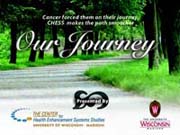
CHESS: Got Hope?
Developed for the Comprehensive Health Enhancement Support System (CHESS) program at the University of Wisconsin - Madison, this video project was designed for disemination both in it's entirety and as short vignettes highlighting individual researchers and contributors. The video was incorporated into and premiered at an industry conference as part of the CHESS booth and display, and later made available online. Each of the individual vignettes were also incorporated into the conference display as repeating loops on monitors throughout the booth.
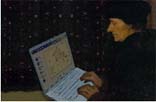
French and Italian Renaissance Literature Online Course
As part of the move towards online instruction at UW-Madison, Dr. Jan Miernowski collaborated with the Engage program to design an interactive course in French and Italian Renaissance literature. My role in the project included developing promotional materials, in the form of short videos, highlighting the benefits of the course, the structure of the course, and the instructional method used, and incorporating them into the marketing website for the course.

UW-Madison Writing Center Training Materials
The Writing Center staff uses QuizVideo, as well as other Engage tools, to help train their staff of tutors. This particular QuizVideo illustrates some of the key concepts involved in opening a dialog with a student and getting the conference off to a good start. For this project I was in charge of lighting, filming, and directing the scene, as well as editing the final version.
MCRC: Argument Balance and Host Bias
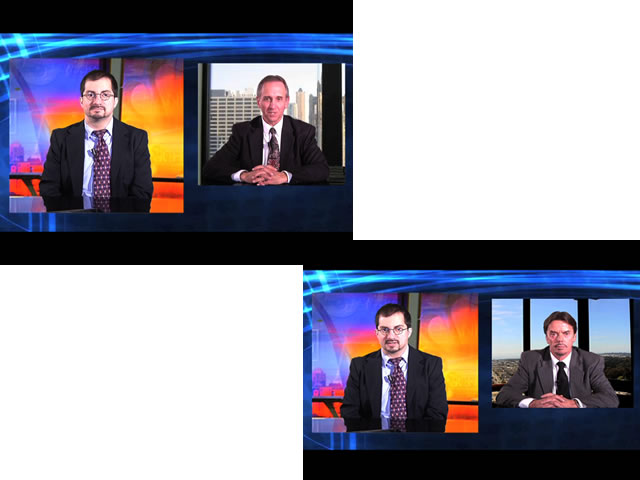
The experimental design employed was developed to isolate the impact of host partisanship and guest argument distribution. In order to systematically manipulate host partisanship, the viewpoint espoused was scripted to be either liberal, conservative, or non-partisan. In the partisan conditions, the host displayed his bias through vocal agreements with the appropriate guest, supportive or derogatory remarks about the positions taken, and targeted uses of aggression. In the non-partisan condition, the host led the debate in a probing manner, questioning the stances and facts put forth by guest in an equivalent manner without advancing an opinion or showing preference to either side.
Argument balance was manipulated by shifting the the flow of the discussion, with the interactions between the host and guests adjusted to provide variations in the number of opportunities provided to each guest to advance their arguments. Each script was designed with the host controlling the flow of the program, either providing each guest with equal opportunities or directing the conversation to favor either the liberal guest or the conservative guest at the expense of the other. This manipulation shifts in the amount of information provided by each guest, with 4 liberal arguments and 4 conservative arguments presented in the balanced condition, 6 liberal arguments and 2 conservative arguments in the liberal-slanted condition, and 2 liberal arguments and 6 conservative arguments in the conservative-slanted condition. The core of each guest’s argument was maintained across conditions, with each making a minimum of one economic and one national security argument to support their position.
To produce the video, professional actors were hired to fill the roles of a host and two topic experts. A television studio with a green screen was used to tape a mock program, allowing the creation of stimuli inline with modern television “talking head” programming with the moderator placed in an in-studio environment and the two guests appearing via video transmissions from remote locations. A professional director (Mitchell Bard) and an experienced video editor (myself) assisted in the development and production of the scripts and stimulus materials, maintaining consistent quality and realism across the different takes and conditions. The news story focused on the issue of illegal immigration and its implications on the economy and national security of the United States. Specifically, it involved two experts, one liberal and one conservative, debating the merits of altering existing immigration policies and practices. The script was designed to mirror actual television programming, with the debate appearing to evolve and shift in an organic fashion. The host opened the segment with a short summary of the topic, questioned the guests on their stances, moderated the ensuing discussion, and closed out the segment with a transition to a commercial break – all of which remained consistent across conditions.
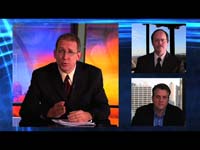
MCRC: Guest Civility and Moderator Tone
The experimental design employed was developed to isolate the impact of guest civility and moderator tone within a televised debate program. We systematically manipulated the extent of guest civility and politeness, as well as the moderators use of humor and aggression, in each of these programs while maintaining the same factual and opinion content across exchanges.
The video was produced in a similar manner to the one above, utilzing professional actors and a television studio with a green screen to create stimuli inline with modern television “talking head” programming . A professional director (Mitchell Bard) and an experienced video editor (myself) assisted in the development and production of the scripts and stimulus materials, maintaining consistent quality and realism across the different takes and conditions. The news story constructed focused on the issue of cap-and-trade and other global warming abatement strategies. Specifically, it involved two experts, one pro-cap-and-trade and one anti-cap-and-trade , debating the merits of a fictional proposed government policy. The script was designed to mirror actual television programming, with the debate evolving and shifting in a seemingly organic fashion. The host opened the program with a short introduction of each guest and a summary of the topic; questioned the guests on their stances; moderated the ensuing discussion; and closed out the segment with a transition to a commercial break – all of which were maintained as constant across conditions.
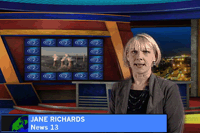
MCRC: Frame Resonance 2
Building off of the study below, this experimental design employed was developed specifically to separate the impact of changes of frame within a television news story – irrespective of content – and changes in facts accompanying those frames. The first experimental factor focused on either the gains of passing or rejecting a fictional piece of legislation regarding nuclear power plants or the losses associated with both outcomes. The second manipulation dealt with the inclusion of varying types of information, as in the first iteration of the study the frames were kept as logically and factually equivalent as possible, while in the second condition additional information that supported the employed frame was added to these basic versions. However, it is important to note that the additional facts were not kept consistent between the two manipulations. Rather, the facts were deliberately designed to reflect real journalistic strategies in which the facts included in stories derive from the frame employed by the journalist. To isolate the impact of the frame from that of the facts, a third fact condition was developed, one that paired additional information dissonant to the frame being presented. In other words, the gain frame condition was paired with information supporting the loss frame and vice-versa. A third manipulation took the form of advocacy, specifically by embedding the news story in a fake YouTube page in which the user who posted the news story either advocated for the use of nuclear power or took a neutral position on the issue.
The news story constructed focused on the issue of nuclear power as a safe and viable alternative energy source. The manipulated broadcast news stories were written and produced with the assistance of media professionals from a local PBS affiliate. Story editors, reporters and television news professionals were involved in the development of the six stories, ensuring that the style and tone of the video and dialogue was consistent both across conditions and with regular television news programming. Additionally, the script drew on existing news coverage for factual information and arguments regarding the pros and cons of nuclear power, including a 60 Minutes segment, "Vive les Nukes," that aired in April 2007. The news stories ran for three minutes, 37 seconds each. The video packages were kept as consistent as possible across conditions, with video maintained across conditions and manipulations contained within the voice-over.
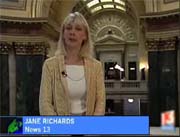
MCRC: Frame Resonance 1
This study was designed to compare the effects of a pure frame manipulation with the effects of the same frame manipulation enhanced with resonant facts. To examine these differences, four versions of the same television news report were produced in conjunction with a professional film crew and veteran reporter from a PBS affiliate. The news story focused on the issue of employee access to healthcare and the rising incidence of bankruptcy resulting from medical expenses among young adults.
Working journalists helped produce these reports, assisting in all stages of their development. We generated a realistic script of each of the different versions of the story corresponding to our proposed experimental manipulations. Once the script was finalized, the professional film and sound crew accompanied the journalist to various locations to shoot footage for the story and to conduct the fictitious interviews. In taking these raw materials and producing the final stories, almost all video elements remained constant. Frame shifts were embedded in voice-overs from the journalist and in short scripted segments by the actors who served as interview subjects. In this way, the style and tone of the video was consistent across all conditions and operated within the norms of broadcast production. This allowed precise control over which frame elements were altered.
Recent News & Thoughts
Selected Research
- Cynics and skeptics: Evaluating the credibility of mainstream and citizen journalism.
- Examining Generational Trends in Overspending, Early Adoption, and Conscientious Consumption from 1994-2004.
- Consumer Culture, Product Placement and the “Fictional Self”
- Precision vs. Realism on the Framing Continuum: Understanding the Underpinnings of Media Effects